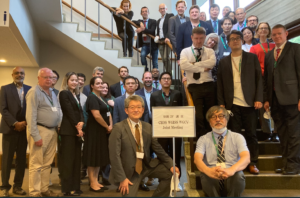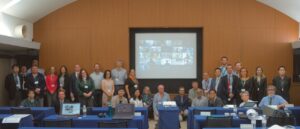
The 6th Joint Symposium with WGCV and WGISS Meeting, Tokyo, October 5, 2022
Makoto NATSUISAKA (WGISS Chair 2022-2023)
Akihiko KUZE (WGCV Chair 2021-2022)
The 6th Joint Symposium with WGCV(the Working Group on Calibration & Validation) and WGISS(the Working Group on Information Systems & Services) was successfully held as an
in-person meeting on 5th October 2022 in Tokyo JAPAN. Seventy-seven members from
21 organizations joined the meeting. The agenda, presentations and
minutes can be found in the WGISS-54 web site.

The joint symposium has been held on a biannual basis since 2008 to
exchange information, identify common interests and foster joint
collaborations. The main topics in this meeting were as follows.
(1) CEOS CAL/VAL Portal, ESA EO Portal, CEOS MIM Database: Status,
Synergies, and Improvements
The status of CEOS CAL/VAL Portal, ESA EO Portal, CEOS Missions,
Instruments, and Measurements (MIM) Database, which are being modernized
was reported to get improvement ideas and consider connectivity with
other CEOS systems. A link between the MIM and the ECV inventory, and
automation for the data providers to enter their information were suggested.
(2) Status of ARD Activities
LSI-VC (Land Surface Imaging Virtual Constellation) introduced CEOS
Analysis Ready Data (ARD) activities to foster engagement of WGCV and
WGISS. The CEOS motivation to engage in ARD activities is to facilitate
data usage by reducing data processing burden on users, looking toward a
future of sensor-agnostic Earth data where the uptake and impact of all
data sources for societal benefit are maximized. CEOS-ARD is a key step
within the ‘interoperability spectrum.’
Overwhelming feedback from industry is that formal standards are needed
for ARD which will facilitate the implementation of CEOS-ARD into
operational workflows and to ensure products interoperability.
(3) Data Quality Assessment and Indicators, and Data Management and Stewardship Maturity Matrix
(3-1) Data Quality Indicators
WGCV gave a presentation on data quality indicators, which can be expressed in
different layers of information (per pixel, per measurement, as cal/val
results summary, as summary quality in the metadata, and in tools and
procedures).
Format is an important aspect of EO data products that ensures they are most
easily accessible to the widest variety of users.
Product metadata and flags offer users important extra layers of useful
descriptive information in addition to the measurements themselves that
can be crucial to their analysis.
A cal/val maturity matrix provides a reader with the high-level summary
of the output of a quality assessment. The matrix contains a column for
each section of analysis and cells for each sub-section of analysis.
Sub-section grades are indicated by the color of the respective grid
cell, which are defined in the key.
(3-2) Data Management and Stewardship Maturity Matrix: Introduction,
Background and Definitions
WGISS gave a presentation on the Data Management and Stewardship Maturity Matrix
(DMSMM). The DMSMM defines all activities needed to preserve and
improve the information content, quality, accessibility, and usability
of data and metadata. It provides a way to measure the status of the
agency data stewardship processes in place, and to plan goals for future data
stewardship processes and projects.
(3-3) AVHRR DMSMM Use Case
The AVHRR DMSMM Use Case was reported. The evaluation is being performed
on the AVHRR L1B Dataset using the Cal/Val Maturity Matrix (a subset of
the DMSMM) and is currently in progress.
(4) CEOS Interoperability Framework Initiative
A presentation on the CEOS Interoperability Framework Initiative was
given by LSI-VC. This framework should help coordinate and
streamline CEOS efforts, and support LSI-VC and SIT decisions.
Addressing the full scope of interoperability requires a framework that
captures all aspects of the problem. The following (non-exhaustive list)
are equally important factors to consider, and each have several
component pieces:
– Structural / Data Architecture
– Accessibility / System / Data Presentation
– Formats / Syntactic / Data Language
– Terminology / Semantics / Data Context
Factors and components are distributed across many CEOS groups (e.g.,
LSI-VC, WGISS, WGCV, etc.), and therefore a robust framework and
coordination mechanisms are needed to address all the necessary pieces.
(5) CEOS Common Online Dictionary: Progress with Joint Activity between
WGISS and WGCV
The CEOS Common Online Dictionary team reported its progress as a result of
a joint collaboration between WGCV and WGISS. The team has completed
the merge of WGCV and WGISS glossaries and NOAA NESDIS Lexicon on a
technical level into a temporary Wiki solution.





